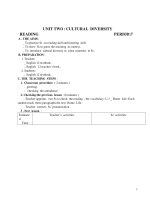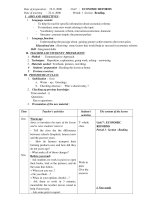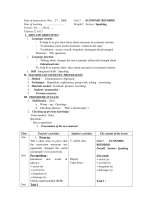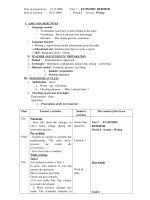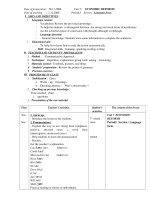LESSON PLAN ISWGR6T3
Bạn đang xem bản rút gọn của tài liệu. Xem và tải ngay bản đầy đủ của tài liệu tại đây (82.07 KB, 15 trang )
Grade 6 – Theme 3: Friends
Lesson 1 - Objectives: by the end of this lesson, students can:
- describe personal appearance.
- use the Present Simple tense and adjectives.
Topic – Language target
Resources and Teaching Aids
Vocabulary:
Resources:
Personal appearance
STUDENT’s BOOK p.24-25
Grammar:
The Present Simple tense and
adjectives
Teaching Aids:
CD1 track 36,37,38,39
Period 21-22
Key Activities
Aims
1. Have students look at the lesson aims as you read them aloud.
2. Have students look at the examples from the Useful Language box.
3. Explain that by the end of the lesson, they'll be able to use the same language.
New words
a. Write the words in the table. Check with a partner. Listen and repeat. (CD1- 36)
1. Demonstrate the activity using the example.
2. Have students write the words in the correct columns.
3. Divide the class into pairs and have them check their answers with their partners.
4. Play audio. Have students listen and repeat.
b. With your partner, add more words to the table. Describe your partner using the new
words. Share with the class.
1. Have pairs add more words to the table.
2. Elicit their words and write them on the board.
3. Have students describe their partner using the new words.
Listening
Listen and number (CD1 - 37)
a. Jake is describing his friends to people at the party. Listen and number the pictures.
1. Play audio and demonstrate the activity using the example.
2. Play audio and have students listen and number the pictures.
3. Play audio again.
4. Play audio and check answer as a whole class.
b. Circle the correct words. Listen again and check.
1. Demonstrate the activity using example.
2. Have students circle the correct words.
3. Play audio again and check answers as a whole class.
Useful language
Listen then practice (CD1-38)
1. Have students look at the Useful Language box.
2. Play audio. Have students listen to the useful language.
3. Have students practice the useful language.
Grammar
Unscramble the sentences
1. Demonstrate the activity using the example.
2. Have students unscramble the sentences.
3. Have students check their answers with a partner.
4. Check answer as a whole class.
5. Have pairs practice saying the sentences.
6. Have some students read their answers in front of the class.
Pronunciation
a. Isolate
Focus on the example and briefly explain the focus.
b. Model (CD1-39)
1. Have students listen and notice the pronunciation feature.
2. Play audio once and draw attention to the pronunciation feature.
c. Practice
Play audio again. Have students listen and repeat with a focus on the feature.
Practice
Practice asking and answering
1. Demonstrate the activity using the example.
2. Divide the class into pairs.
3. Have pairs ask and answer using the questions and the pictures.
4. Have some pairs demonstrate the activity in front of the class.
Speaking
What Do They Look Like?
a. You’ve lost your friends at a party. Student A, turn to page 105, File 3. Student B, turn to
page 106, File 5.
b. Take turns describing friends in your class for your partner to guess.
1. Have Student A turn to page 105, File 3 and Student B turn to page 106, File 5.
2. Demonstrate the activity by asking and answering with one student.
3. Have students take turns describing and guessing about their friends in class.
4. Have some pairs demonstrate the activity in front of the class.
Grade 6 – Theme 3: Friends
Lesson 1 - Objectives: use vocabulary to describe personal appearance
Period 21-22
use the Present Simple tense and adjectives
Topic – Language target
Resources and Teaching Aids
Vocabulary:
Resources:
Personal appearance
WORKBOOK p.22-23
Grammar:
The Present Simple tense and
adjectives
Key Activities
New Words
Look at the pictures. Complete the descriptions using the words in the box.
1. Have students look at the pictures.
2. Draw students’ attention to the blanks in the descriptions.
3. Have students look at the words in the box.
4. Demonstrate the activity using the example.
5. Have students complete the descriptions using the words in the box.
6. Check answers as a whole class.
Grammar
a. Write the hair descriptions under the pictures.
1. Have students look at the pictures.
2. Demonstrate the activity using the example.
3. Have students write the hair description under the pictures.
4. Have students check their answers with partners.
5. Check answer as a whole class.
b. Match 1-5 with A-E to complete a conversation between two friends. Who’s Emma’s
brother? Tick the correct photo.
1. Have students look at the conversation.
2. Draw students’ attention to the information A-E in the box.
3. Demonstrate the activity using the example.
4. Have students complete the conversation between two friends.
5. Have students look at the photo.
6. Have students tick the photo of Emma’s brother.
7. Check answer as a whole class.
c. Unscramble the sentences.
1. Demonstrate the activity using the example.
2. Have students unscramble the sentences.
3. Have students check their answers with partners.
4. Check answers as a whole class.
Write
Write a description of your best friend.
1. Have students think of his/her best friend.
2. Have students describe his/her best friends.
3. Have some students demonstrate their writing in front of the class.
Grade 6 – Theme 3: Friends
Lesson 2 - Objectives: by the end of this lesson, students can:
- invite someone to do an activity which friends often do together.
- use the Present Continuous tense for future plans.
Period 23-24
Topic – Language target
Vocabulary:
Activities which friends often
do together
Resources and Teaching Aids
Resources:
STUDENT’s BOOK p.26-27
Key Activities
Aims
1. Have students look at the lesson aims as you read them aloud.
2. Have students look at the examples from the Useful Language box.
3. Explain that by the end of the lesson, they'll be able to use the same language.
Grammar:
The Present Continuous tense
for future plans
Teaching Aids:
CD1 - Track 40, 41, 42, 43
New words
a. Write the words in the table. Check with a partner. Listen and repeat. (CD1-40)
1. Demonstrate the activity using the example.
2. Have students write the words in the correct columns.
3. Divide the class into pairs and have them check their answers with their partners.
4. Play audio. Have students listen and repeat.
b. With your partner, add more words to the table. Tell your partner which activities you
want to do this weekend. Share with the class.
1. Have pairs add more words to the table.
2. Elicit their words and write them on the board.
3. Have pairs talk about which activities they want to do this weekend.
4. Have some pairs share with the class.
Listening
a. Two friends are inviting each other out. Listen and write “Yes” or “No”. (CD1 – 41)
1. Play audio and demonstrate the activity using the example.
2. Play audio and have students listen and write “True” or “False”
3. Play audio again and check answers as a whole class.
b. Fill in the blanks. Listen again and check.
1. Demonstrate the activity using the example.
2. Have students fill in the blanks.
3. Play audio again. Have students listen and check.
Useful language
Listen then practice (CD1-42)
1. Have students look at the Useful Language box.
2. Play audio. Have students listen to the useful language.
3. Have students practice the useful language.
Grammar
Fill in the blanks
1. Demonstrate the activity using the example.
2. Have students write the correct form of the verbs to complete the sentence.
3. Have students check their answers with a partner.
4. Check answers as a whole class.
5. Have students practice saying the sentences.
6. Have some students read the complete sentences in front of the class.
Pronunciation
a. Isolate
Focus on the example and briefly explain the focus.
b. Model (CD1-43)
1. Have students listen and notice the pronunciation feature.
2. Play audio once and draw attention to the pronunciation feature.
c. Practice
Play audio again. Have students listen and repeat with a focus on the feature.
Practice
Practice the conversation
1. Have students look at the conversation.
2. Divide the class into pairs and have them practice the conversation.
3. Swap roles and repeat.
4. Have some pairs demonstrate the activity in front of the class.
Speaking
Our free time
a. You’re making a plan for the next two weeks. Work in pairs. Student B, turn to page 105,
File 4. Look at your calendar for Week 1 and take turns asking about plans and inviting each
other to do activities. When you’re both free, agree on an activity to do together.
1. Demonstrate the role-play by asking and answering with one student.
2. Divide the class into pairs.
3. Have Student A look at the schedule on the bottom of the page and Student B turn to page
105, File 4.
4. Have students fill in their calendars and leave the dates that say “free” blank.
5. Have students do the role-play for Week 1.
6. Have students find out which days they’re both free and choose an activity to do together.
b. Complete your calendar for Week 2 with activities. Continue the conversation.
1. Have students fill in the blanks for Week 2 using their own ideas and continue the
conversation.
2. Have some students demonstrate the role-play in front of the class.
Grade 6 – Theme 3: Friends
Lesson 2 - Objectives: use vocabulary to talk about activities which friends often do together.
use the Present Continuous tense for future plans.
Topic – Language target
Resources and Teaching Aids
Key Activities
Vocabulary:
Resources:
New Words
Activities which friends often
WORKBOOK p.24-25
a. Match the words with the verbs in the box to make phrases.
do together
1. Have students look at the words 1-10.
2. Draw students’ attention to the verbs in the box.
Period 23-24
Grammar:
The Present Continuous tense
for future plans
3. Demonstrate the activity using the example.
4. Have students match the words with the verbs in the box to make phrases.
5. Have students check their answers with partners.
6. Check answers as a whole class.
b. Label the pictures using the phrases in Exercise a.
1. Have students look at the pictures.
2. Demonstrate the activity using the example.
3. Have students label the pictures using the phrases in Exercise a.
4. Have students check their answers with partners.
5. Check answers as a whole class.
c. Fill in the blanks using the phrases in Exercise a.
1. Have students look at the sentences.
2. Draw students’ attention to the blank in each sentence.
3. Demonstrate the activity using the example.
4. Have students fill in the blanks using the phrases in Exercise a.
5. Have students check their answers with partners.
6. Check answers as a whole class.
Grammar
a. Write the -ing forms of the verbs.
1. Demonstrate the activity using the example.
2. Have students write the -ing forms of the verbs.
3. Have students check their answers with partners.
4. Check answers as a whole class.
b. Read the sentences. Circle the correct answers.
1. Have students look at the sentences.
2. Draw students’ attention to the blank in each sentence.
3. Have students look at three choices in each sentence.
4. Demonstrate the activity using the example.
5. Have students read the sentences and circle the correct answers.
6. Have students check their answers with partners.
7. Check answers as a whole class.
c. Unscramble the sentences.
1. Demonstrate the activity using the example.
2. Have students unscramble the sentences.
3. Have students check their answers with partners.
4. Check answer as a whole class.
Write
Give your own ideas. Write full sentences.
1. Have students look at the questions.
2. Have students write full answers giving their own ideas.
3. Have students check their answers with partners.
4. Have some students demonstrate the activity in front of the class.
Grade 6 – Theme 3: Friends
Period 25-26
Lesson 3 - Objectives: by the end of this lesson, students can:
- talk about what you need for a trip.
- use “need” and “don’t need” for different situations.
Topic – Language target
Resources and Teaching Aids
Key Activities
Vocabulary:
Resources:
Aims
Things you need for a trip
STUDENT’s BOOK p.28-29
1. Have students look at the lesson aims as you read them aloud.
2. Have students look at the examples from the Useful Language box.
3. Explain that by the end of the lesson, they'll be able to use the same language.
New words
a. Write the words under the pictures. Check with a partner. Listen and repeat. (CD1-44)
Grammar:
Use “need” and “don’t need”
for different situations
Teaching Aids:
CD1 track 44, 45, 46, 47
1. Demonstrate the activity using the example.
2. Have students write the words under the pictures.
3. Divide the class into pairs and have them check their answers with their partners.
4. Play audio. Have students listen and repeat.
b. With your partner, talk about which of these items you have in your home. Share with the
class.
1. Have pairs discuss which items they have at home.
2. Have some pairs share with the class.
Listening
a. Two students are planning their school camping trip. Listen and circle “True” or “False”.
(CD1 - 45)
1. Play audio and demonstrate the activity using the example.
2. Play audio and have students listen and circle “True” or “False”.
3. Play audio again and check answers as a whole class.
b. Fill in the blanks. Listen again and check.
1. Demonstrate the activity using the example.
2. Have students fill in the blanks.
3. Play audio again. Have students listen and check.
Useful language
Listen then practice (CD1-46)
1. Have students look at the Useful Language box.
2. Play audio. Have students listen to the useful language.
3. Have students practice the useful language.
Grammar
Unscramble the sentences
1. Demonstrate the activity using the example.
2. Have students unscramble the sentences.
3. Have students check their answers with a partner.
4. Check answers as a whole class.
5. Have students practice asking and answering.
6. Have some students demonstrate the activity in front of the class.
Pronunciation
a. Isolate
Focus on the example and briefly explain the focus.
b. Model (CD1-47)
1. Have students listen and notice the pronunciation feature.
2. Play audio once and draw attention to the pronunciation feature.
c. Practice
Play audio again. Have students listen and repeat with a focus on the feature.
Practice
Practice the conversation
1. Have students look at the conversation.
2. Divide the class into pairs and have them practice the conversation.
3. Swap roles and repeat.
4. Have some pairs demonstrate the activity in front of the class.
Speaking
Preparing for an Overnight Adventure
a. You’re preparing for a camping trip. Work in pairs. Take turns asking your partner what you
should bring with you. Choose five items.
1. Demonstrate the activity by asking one student the first two questions.
2. Divide the class into pairs.
3. Have students look at the information in the table.
4. Have students take turns asking their partner what they should bring with them and choose
five items.
b. Compare your list with another pair. Did you choose any of the same things? Share with
the class.
1. Have students compare their lists to see if they choose any of the same things.
2. Have some pairs explain one of their choices in front of the class.
Grade 6 – Theme 3: Friends
Lesson 3 - Objectives: use vocabulary to talk about what you need for a trip
use “need” and “don’t need” for different situations
Topic – Language target
Vocabulary:
Things you need for a trip
Grammar:
Use “need” and “don’t need”
for different situations
Resources and Teaching Aids
Resources:
WORKBOOK p.26-27
Period 25-26
Key Activities
New Words
a. Complete the words. Match them with the objects in the picture below.
1. Have students look at the objects in the picture.
2. Draw students’ attention to number of letters in each word.
3. Demonstrate the activity using the example.
4. Have students complete the words and match them with the objects in the picture.
5. Have students check their answers with partners.
6. Check answers as a whole class.
b. Fill in the blanks using the words in Exercise a.
1. Have students look at the sentences.
2. Draw students’ attention to the blank in each sentence.
3. Demonstrate the activity using the example.
4. Have students fill in the blanks using the words in Exercise a.
5. Have students check their answers with partners.
6. Check answers as a whole class.
Grammar
a. Match the questions with the answers.
1. Demonstrate the activity using the example.
2. Have students match the questions with the answers.
3. Have students check their answers with partners.
4. Check answers as a whole class.
b. Jim and John are going to go camping at the campsite. Look at their notes. Write the
answers.
1. Have students look at the questions.
2. Draw students’ attention to the notes.
3. Demonstrate the activity using the example.
4. Have students write answers for questions.
5. Have students check their answers with partners.
6. Check answers as a whole class.
Write
Fill in the table. Give your own ideas.
1. Have students look at the questions.
2. Have students write full answers giving their own ideas.
3. Have students check their answers with a partner.
4. Have some students demonstrate their writing in front of the class.
Grade 6 – Theme 3: Friends
Period 27-28
Lesson 4 - Objectives: by the end of this lesson, students can:
- describe someone’s character and write a description about your best friend.
- use adjectives to describe someone.
Topic – Language target
Resources and Teaching Aids
Key Activities
Vocabulary:
Resources:
Aims
adjectives to describe
STUDENT’s BOOK p.30-31
1. Have students look at the lesson aims as you read them aloud.
someone’s character
2. Have students look at the examples from the Useful Language box.
3. Explain that by the end of the lesson, they'll be able to use the same language.
Structure:
- Who is someone’s favorite
character?
- What is + S + like?
Teaching Aids:
CD1-Track 48, 49, 50, 51
New words
a. Write the words in the table. Check with a partner. Listen and repeat. (CD1- 48)
1. Demonstrate the activity using the example.
2. Have students write the words in the correct columns as positive or negative adjectives. If
something is neither positive nor negative, have students write them in “others”.
3. Divide the class into pairs and have students check their answers with their partners.
4. Play audio. Have students listen and repeat.
b. With your partner, describe your friends in your class using the new words. Share with the
class.
1. Have pairs describe their friends in their class using the new words.
2. Have some pairs share with the class.
Listening
a. You will hear a talk about Anne Frank. Listen and write “True” or “False”. (CD1 - 49)
1. Play audio and demonstrate the activity using the example.
2. Play audio and have students listen and write “True” or “False”
3. Play audio again and check answers as a whole class.
b. Circle the correct words. Listen and check. (CD1 - 50)
1. Demonstrate the activity using the example.
2. Have students circle the correct words.
3. Play audio again. Have students listen and check.
Useful language
Listen then practice (CD1-51)
1. Have students look at the Useful Language box.
2. Play audio. Have students listen to the useful language.
3. Have students practice the useful language.
Reading
a. Read a summary from the story Tam Cam. With your partner, discuss what you can learn
from the story. Share with the class.
1. Have students read the summary from the story.
2. Divide the class into pairs.
3. Have pairs discuss what they can learn from the story.
4. Have some pairs share with the class.
b. Read the summary again and write “Yes” or “No”
1. Have students read the text again.
2. Demonstrate the activity using the example.
3. Have students write “Yes” or “No”
4. Check answers as a whole class.
Speaking
Describe People’s Character
a. You’re in a book club meeting. Work in fours. Talk about and describe your favorite
characters from stories, movies or comic books. Write their names in the box.
b. Share with the class.
1. Demonstrate the activity using the example.
2. Divide the class into groups of four.
3. Have students choose their favorite characters from stories, movies or comic books.
4. Have students take turns asking and answering about their favorite characters.
5. Have students complete the table.
6. Have some students share their ideas with the class.
Writing
Write about your best friend. Describe what he/she looks like and his/her character. Give
examples of his/her behavior.
1. Demonstrate the activity using the example.
2. Have students write a description about their best friend.
3. Have some students read their writing in front of the class.
Grade 6 – Theme 3: Friends
Lesson 4 - Objectives: - use vocabulary to describe someone’s character and write a description about your best friend.
- develop reading comprehension skill.
Topic – Language target
Vocabulary:
adjectives to describe
someone’s character
Structure:
- Who is someone’s favorite
character?
- What is + S + like?
Resources and Teaching Aids
Resources:
WORKBOOK p.28-29
Key Activities
New Words
a. Complete the words with the vowels (a, e, i, o, u) and y.
1. Have students look at the words.
2. Draw students’ attention to the blank in each word.
3. Demonstrate the activity using the example.
4. Have students complete the words with the vowels and y.
5. Have students check their answers with partners.
6. Check answers as a whole class.
b. Fill in the blanks with the adjectives in Exercise a.
1. Have students look at the sentences.
2. Draw students’ attention to the blanks in sentences.
3. Demonstrate the activity using the example.
4. Have students fill in the blanks with the adjectives in Exercise a.
5. Have students check their answers with partners.
6. Check answers as a whole class.
Read
a. Read the text. Circle True or False.
1. Have students look at the text.
2. Draw students’ attention to the information 1-5
3. Demonstrate the activity using the example.
4. Have students read the text and circle True or False.
5. Check answers as a whole class.
b. Read the text again. Write the answers.
1. Have students look at the text again.
2. Draw students’ attention to questions 1-5.
Period 27-28
3. Demonstrate the activity using the example.
4. Have students read the text and write the answers for questions.
5. Check answers as a whole class.
Write
a. Unscramble the sentences and give your own ideas.
1. Demonstrate the activity using the example.
2. Have students unscramble the sentences and give their own ideas to answer the questions.
3. Have students check their answers with partners.
4. Check answers as a whole class.
b. Answer the questions about your father/mother. Then write a description about him/her.
1. Have students look at the questions.
2. Demonstrate the activity using the example.
3. Have students answer the questions.
4. Have students use the answers to write a description about their mother/ father.
5. Have some students demonstrate their writing in front of the class.
Grade 6 – Theme 3: Friends
Period 29-30
Lesson 5 - Objectives: Review and Test practice
Topic – Language target
Vocabulary:
Review all vocabulary
- How to describe people’s
appearance and character.
- How to talk about activities
friends do together and
preparing for a camping trip.
Resources and Teaching Aids
Resources:
STUDENT’s BOOK p.32-33
Structure:
Review all structures
Teaching Aids:
CD1 – Track 52
Key Activities
Listening
Listen and tick (CD1-52)
1. Play audio and demonstrate the activity using the example.
2. Play audio and have students listen and tick A, B or C.
3. Play audio again.
4. Play audio and check answers as a whole class.
Reading
Read and fill in
1. Demonstrate the activity using the example.
2. Have students read and fill in the information.
3. Check answers as a whole class.
Speaking
Play the “Block Buster” game
1. Divide the class into groups of four. Each group has two teams with two students in each
team.
2. Have teams play rock, paper, scissors. The winning team chooses a block and asks and
answers.
3. The team with correct answer marks the block. The other team can’t use that block.
4. Have the teams take turns.
5. The winning team is the team that creates a line of blocks from one side to the other. Pair 1:
from orange to orange. Pair 2: from blue to blue.
Writing
Write an email
1. Have students look at the email.
2. Have students write a 25 to 35- word email to answer the questions.
3. Have some students read their emails in front of the class.
Grade 6 – Theme 3: Friends
Period 29-30
Lesson 5 - Objectives: Review and Test practice
Topic – Language target
Vocabulary:
Review all vocabulary
- How to describe people’s
appearance and character.
- How to talk about activities
friends do together and
preparing for a camping trip.
Structure:
Review all structures
Resources and Teaching Aids
Resources:
WORKBOOK p.30-31
Key Activities
Part 1
Look and complete
Look at the pictures. Then use the words on the left to complete the descriptions of Daniel and
Sally.
1. Demonstrate the activity using the example.
2. Have students look at the pictures.
3. Draw students’ attention to the words on the left.
4. Have students complete the sentences 1-7.
5. Divide the class into pairs and have them check their answers.
6. Check answers as a whole class.
Part 2
Find the words in the word search
1. Have students look at the word search.
2. Demonstrate the activity using the example.
3. Draw students’ attention to the words in the box.
4. Have students find the words in the word search.
5. Have students circle their findings.
6. Divide the class into pairs and have them check their findings.
7. Check answers as a whole class.
Part 3
Read and mark
Complete the five conversations. Mark A, B or C.
1. Have students read the questions.
2. Draw students’ attention to the three choices A, B and C.
3. Demonstrate the activity using the example.
4. Have students read and complete the conversations by marking A, B or C.
5. Check answers as a whole class.
Part 4
Read and mark
Complete the conversation between two friends. What does Vicky say to Tom? Mark the
correct letter A-H.
1. Demonstrate the activity using the example.
2. Have students read and complete the conversation by marking A-H.
3. Check answers as a whole class.
